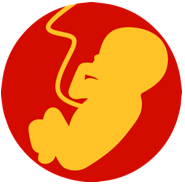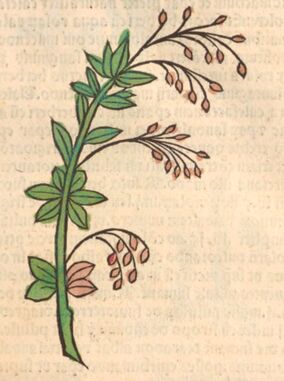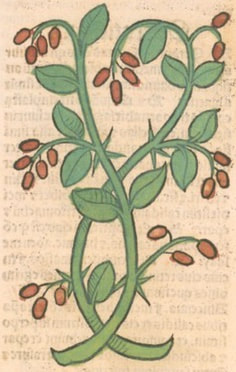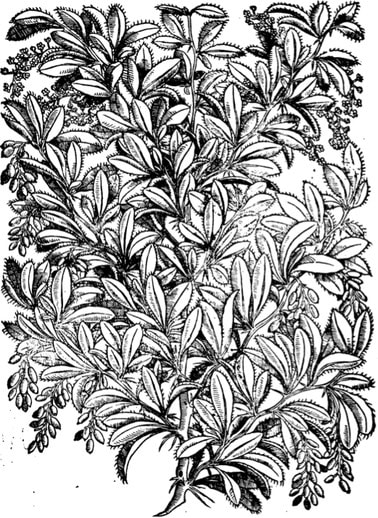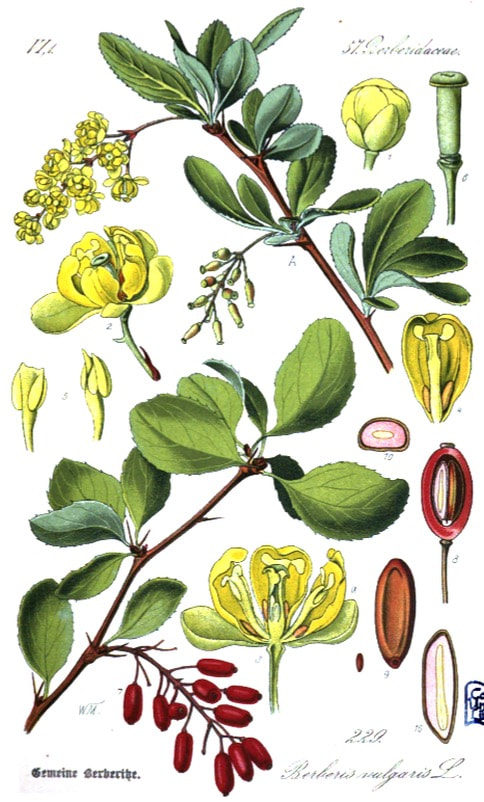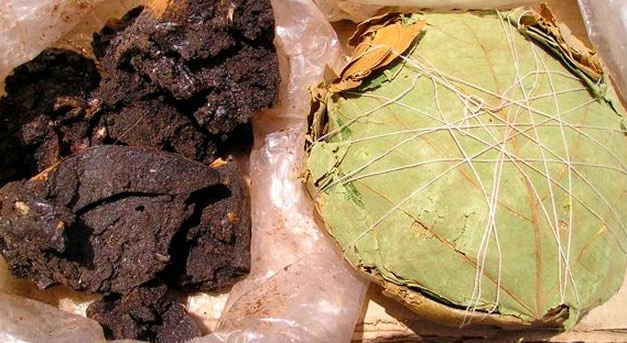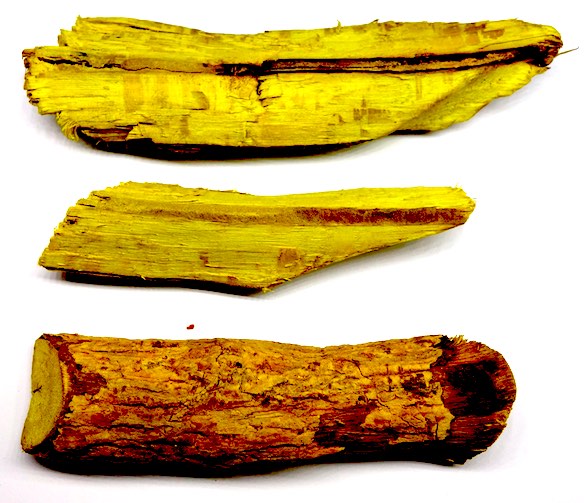Sentry Page Protection
Berberis, BarberryLycium (classical name)
Barberry root: –Xiao Bo (TCM) –Daruharidra (Ayurveda) –Skyer pa སྐྱེར་པ (Tibetan) Bark: –Skyer shun སྐྱེར་ཤུན (Tibetan) Stem: –Maramancal (Siddha) Concentrated Extract of Bark/Stem: –Rasanjana (Ayurveda) –Rasaut (Unani) –Skyer ba'i khan ta སྐྱེར་པའི་ཁཎྜ (Tibetan) Fruit: –Zarishk (fruit, Unani) Seed: –Skyer ba'i 'bru སྐྱེར་པའི་འབྲུ (Tibetan) |
New Kreuterbuch, Matthiolus, 1563
B. vulgaris
Flora von Deutschland, Kohler, 1886
Flora von Deutschland, Kohler, 1886
Botanical name:
Berberis spp.
Other species include B. orthobotrys (Pakistan), B. croatica (Croatia), B. calliobotiys (Iran), B. libanotica (Syria, Lebanon)
The Chinese Pharmacopoeia lists B. soulieana "and other species of the same genus" as the source for Barberry bark.
In Tibetan Medicine, several types of Berberis are used:
Parts used:
1. Root, Root-Bark
2. Concentrated extract formed by boiling down the root and stems, or whole plant is used. (India, Unani and Tibet)
3. Fruit;
Temperature & Taste:
Fruit: Cool, moist when fresh; Cool, dry when dry; Sour
Bark/Extract: Cold, dry. Bitter of thin parts, gently binding
Avicenna said the extract is "Moderately Hot and Cold but Dry in the second degree".
Classification:
2B ATTENUATER. 2F. PURIFYING. 2N. REPELLENTS
3B. FEBRIFUGE & ANTIPYRETIC. 3L. ANTI-TUSSIVE
4b. OPTHALMIC. 4e. STOMACHIC. 4g. HEPATIC
TCM:
B. Clears Heat and Damp
Berberis spp.
- B. vulgaris (standard species of West and Unani)
- B. asiatica, B. lycium, B. asiatica (Indian Barberry, Ayurveda, Tibet)
- B. amurensis, B. soulieana (Chinese Barberry, TCM)
- B. concinna, B. dictophylla (Tibet)
- B. nepalensis (Nepal)
Other species include B. orthobotrys (Pakistan), B. croatica (Croatia), B. calliobotiys (Iran), B. libanotica (Syria, Lebanon)
The Chinese Pharmacopoeia lists B. soulieana "and other species of the same genus" as the source for Barberry bark.
In Tibetan Medicine, several types of Berberis are used:
- Skyer pa སྐྱེར་པ : B. aristata
- Skyer pa dkar po ('White' variety) སྐྱེར་པདཀར་པོ : B. lycium
- Skyer pa nag po ('Black' variety) སྐྱེར་པནག་པོ : B. concinna
Parts used:
1. Root, Root-Bark
2. Concentrated extract formed by boiling down the root and stems, or whole plant is used. (India, Unani and Tibet)
3. Fruit;
Temperature & Taste:
Fruit: Cool, moist when fresh; Cool, dry when dry; Sour
Bark/Extract: Cold, dry. Bitter of thin parts, gently binding
Avicenna said the extract is "Moderately Hot and Cold but Dry in the second degree".
Classification:
2B ATTENUATER. 2F. PURIFYING. 2N. REPELLENTS
3B. FEBRIFUGE & ANTIPYRETIC. 3L. ANTI-TUSSIVE
4b. OPTHALMIC. 4e. STOMACHIC. 4g. HEPATIC
TCM:
B. Clears Heat and Damp
Uses:
BARBERRY BARK / STEM / EXTRACT
1. Clears Heat and Damp: (West, Unani, Ayurveda, Tibet)
-benefit the Stomach and Liver, promotes Appetite
-good when cooling and binding is needed: Enteritis, Diarrhea, Dysentery etc.
-cholecystitis, Gall stones, Jaundice, Hepatitis
-Liver headache, migraine, hypertension
-painful urination, strangury, Urinary Tract Infection
-red, hot swollen, painful joints: Arthritis, Gout, Rheumatism. Avicenna said "It strengthens the joints".
2. Clears Heat and Phlegm, Stops Cough: (West, Unani, Ayurveda, Tibet)
-acute respiratory tract infection; Cough, Bronchitis
3. Clears Heat, Quenches Thirst: (West, Unani, Ayurveda, Tibet)
-Fevers, Malaria, Cholera
-Thirst, Consumption
4. Cools the Blood, Stops Bleeding: (West, Unani, Ayurveda, Tibet)
-Itch, Eczema, Erysipelas
-excess Bleeding from Heat
-"useful in all types of Bleeding". (Avicenna)
-"prevents excessive menstrual discharge". (Avicenna)
5. Clears Heat, Resists Poison: (West, Unani, Tibet)
-Poisoning
-Rabies
-Toxic Swellings
-red or painful eyes; mouth sores
6. Kills Worms:
-adjunct for Worms
7. Externally:
i. fruit is used topically to strengthens the gums and fastens the teeth;
ii. a weak infusion makes a good compress for heat and inflammation of the Eyes; used for Conjunctivitis, starting Cataracts and Trachoma. The extract is used in India for Opthalmia and Conjunctivitis
iii. a wash of the bark or root is used externally for Eczema and Neuro-dermatitis.
iv. strong decoction is used topically to promote hair growth
v. Herpes and other skin infections.
vi. "useful in Malignant Ulcers". (Avicenna)
vii. "useful in cases of Anal Fissures". (Avicenna)
viii. Ear infections with Pus, and for Ulcers of the Ear
ix. Sores, Inflammations and Ulcers of the Mouth, Palate and Gums (bark, extract)
BARBERRY FRUIT
1. Nourish and Strengthen the Liver
-Liver deficiency
2. Clears Heat, Nourishes Yin
-Fever, Fever with Yin deficiency
-Hemoptysis, Blood in the Stool
2. Astringes to Stop Leakage
-diarrhea
-excess Menstruation
Preparation:
Barberry Extracty:
An extract prepared by decocting the whole plant down until thick, then evaporating until dry. Avicenna describes its preparation: the extract "is obtained either by crushing its fresh leaves including the whole plant or the material is soaked in water and kept for a number of days and then repeatedly decocted till it becomes thick ... Sometimes it is prepared by pressing the fruits after they are kept in the sun".
It has similar effects to the bark, being bitter, cholagogue, antipyretic, antiseptic and anti-diarrhoeal. It is especially use externally for eye diseases.
Dose
Decoction of root-bark / stem: 6–12 grams
Powder of the root-bark / stem, or fruit: 1–3 grams
Corrective:
Sugar, Clove (Unani)
Substitute:
WOOD / BARK:
1. White Sandalwood (Unani)
2. "Equal weights of Betel Nut and Sandalwood taken together also act as its substitute" (Avicenna)
3. Scutellaria Huang Qin can usually be used in place of Barberry root-bark.
4. Phellodendron Huang Bai. (Huang Bai was classically obtained from Berberis species, but water later collected from Phellodendron) (see here). Phellodendron amurense bark is used as a substitute in Buryat.
5. Turmeric (Ayurveda)
EXTRACT:
1. Accordng to Ayurvedic texts, if the extract is not vailable, the wood can be used.
FRUIT:
1. Cornus Shan Zhu Yu may be a suitable substitute for Barberry fruit. The fruit of Barberry species was apparently a classical source of Shan Zhu Yu in China.
Barberry Extracty:
An extract prepared by decocting the whole plant down until thick, then evaporating until dry. Avicenna describes its preparation: the extract "is obtained either by crushing its fresh leaves including the whole plant or the material is soaked in water and kept for a number of days and then repeatedly decocted till it becomes thick ... Sometimes it is prepared by pressing the fruits after they are kept in the sun".
It has similar effects to the bark, being bitter, cholagogue, antipyretic, antiseptic and anti-diarrhoeal. It is especially use externally for eye diseases.
Dose
Decoction of root-bark / stem: 6–12 grams
Powder of the root-bark / stem, or fruit: 1–3 grams
Corrective:
Sugar, Clove (Unani)
Substitute:
WOOD / BARK:
1. White Sandalwood (Unani)
2. "Equal weights of Betel Nut and Sandalwood taken together also act as its substitute" (Avicenna)
3. Scutellaria Huang Qin can usually be used in place of Barberry root-bark.
4. Phellodendron Huang Bai. (Huang Bai was classically obtained from Berberis species, but water later collected from Phellodendron) (see here). Phellodendron amurense bark is used as a substitute in Buryat.
5. Turmeric (Ayurveda)
EXTRACT:
1. Accordng to Ayurvedic texts, if the extract is not vailable, the wood can be used.
FRUIT:
1. Cornus Shan Zhu Yu may be a suitable substitute for Barberry fruit. The fruit of Barberry species was apparently a classical source of Shan Zhu Yu in China.
Main Combinations:
Barberry & Turmeric
1. Fever; Heat of the Liver, Bladder, Breast, Stomach, combine Barberry concentrated juice, Licorice, Tabasheer, Rose, Purslane seed, Tragacanth, Camphor (as in Troches of Barberries)
2. Recurring or Daily Fever:
i. Barberry, Gentian, Yarrow, Wormwood, Licorice
ii. Barberry with Rose, Tabasheer, Agrimony, Dodder seed, Endive seed, Tragacanth, Wormwood, Aniseed (as in Troches for Daily Fever of Galen)
3. Bronchitis:
i. Barberry, Thyme
ii. Barberry, Echinacea, Golden Seal, Licorice
4. Biliousness, Barberry with Chebula and Lesser Cardamon
5. Jaundice:
i. Barberry with Centaury
ii. Barberry with Turmeric, Celandine, Saffron;
iii. Barberry with Turmeric, Dandelion, Agrimony
iv. Barberry with Wormwood, Dandelion, Rhubarb
6. Cholecystitis: Barberry with Dandelion, Wormwood
7. Liver Heat and Gall Bladder disease:
i. Barberry with Dandelion, Turmeric, Agrimony
ii. Barberry with Sandalwood, Rose
iii. Barberry root with Turmeric, Picrorhiza, Bishop's Weed seed (Ayurveda)
8. Eczema:
i. Barberry, Dandelion, Rhubarb, Licorice
ii. Barberry, Fumitory, Violet
iii. Barberry, Centella, Eclipta, Madder
9. Skin conditions associated with Liver heat:
i. Barberry, Madder, Neem, Eclipta, Psoralea (Ayurveda)
ii. Acne, Eczema, Dermatitis, Leucoderma, Barberry, Cassia tora, Turmeric, Neem, Madder, Swertia, Picrorrhiza (Ayurveda)
10. Poor Appetite related to Liver, Barberry with Chicory, Wormwood, Blessed Thistle, Centaury (Weinhart)
11. Indigestion:
i. with food sensitivity, Barberry fruit, Wormwood, Ginger
ii. with Depression, Barberry fruit, Rosemary, Balm
12. Gastric Ulcer, Golden Seal, Calendula, Licorice
13. Dysentery
i. Barberry with Tragacanth, Galls, Red Earth
ii. Barberry, Chebula, Boerhaavia, Tinospora, Ginger (Unani, proven effective)
iii. Barberry, Costus, Chebula
14. Hemorrhoids, Barberry with Aloe, Triphala, Neem, Tinospora (Ayurveda)
15. Gout, excess Uric acid, Barberry bark (2 parts), Agrimony, Yarrow, Peppermint, Balm, Nettle (1 part each)
16. Excess Menstruation, Uterine Bleeding from Heat:
i. Barberry root decocted in red wine (Herbarium Horstianum, 1630)
ii. Barberry seed with Tormentil, Comfrey, Sorrel, Gum Arabic, Tragacanth, Plantain juice
17. Acute sore throat, combine Barberry with Sage
18. Influenza, Barberry with Yarrow, Elder flower
19. Consumption, Barberry with Raspberry leaf and Agrimony
20. Oil for Skin diseases, Barberry with Turmeric, Rock Salt, Psoralea, boiled in coconut milk (Siddha)
Major Formulas
Confection for all Diseases of the Eyes
Decoction of Dandelion
Decoction for Excessive Menstruation
Powder for Vomiting from Phlegm and Bile (1)
Powder for Vomiting from Phlegm and Bile (2)
Troches of Barberries (Trochisci de Berberis) (Mesue)
Troches of Gum Lacca (Trochisci de Lacca) (Mesue)
Troches of Spodium (Trochisci Spodii) (Avicenna)
Troches of Sandalwoods (Trochisci Santalon) (Mesue)
Troches for Hardness of the Liver (Nicholas)
Pills of Leek (Unani)
Electuary for Quotidian, Tertian and Quartan Fever (Galen)
Arsoghni Vati (Ayurveda)
Barberry 8 Powder (Skyer sun brgyad pa) (Tibetan)
Betel Nut 28 (Go yu nyer brgyad) (Tibetan)
Emblic 6 (Kyu ru duk pa) (Tibetan)
Turmeric Decoction 4 (Yung ba 4) (Tibetan)
Chebula 18 for Urinary Incontinence (Gcin snyi a ru 18) (Tibetan)
Possessor of Ruby Color (Pad rag mdog ldan) (Tibetan)
Swertia 5 Decoction (Tig ta lnga thang) (Tibetan)
Swertia 8 (Tig ta brgyad pa)
Cautions:
1. Not used in Cold and weak digestion
2. Generally not used in Pregnancy
Toxicity:
Toxic in Overdose. Symptoms may include Gastro-Intestinal upset, Ulceration, Immunotoxicity, Phototoxicity, Neuro-toxicity, Cardiotoxicity and Jaundice.
Main Preparations used:
Dried or prepared Fruit, clarified Juice of the Berries, Rob, and Troches were used
Rob of Barberries:
i. take ripe barberries, bruise them, then set aside for 3 days; express the juice and evaporate over a gentle heat to the thickness of Honey with one-quarter sugar. (Pharmacopoeia medici practici universalis, Bruxelles, 1817)
1. Not used in Cold and weak digestion
2. Generally not used in Pregnancy
Toxicity:
Toxic in Overdose. Symptoms may include Gastro-Intestinal upset, Ulceration, Immunotoxicity, Phototoxicity, Neuro-toxicity, Cardiotoxicity and Jaundice.
Main Preparations used:
Dried or prepared Fruit, clarified Juice of the Berries, Rob, and Troches were used
Rob of Barberries:
i. take ripe barberries, bruise them, then set aside for 3 days; express the juice and evaporate over a gentle heat to the thickness of Honey with one-quarter sugar. (Pharmacopoeia medici practici universalis, Bruxelles, 1817)
Click the Tabs above for more information on this Medicine
|
'The medical practitioners of ancient Greece and Italy made use of a substance called Lycium of which the best kind was brought from India. It was regarded as a remedy of great value in restraining inflammatory and other discharges; but of all the uses to which it was applied the most important was the treatment of various forms of ophthalmic inflammation.
Lycium is mentioned by Dioscorides, Pliny, Celsus, Galen, and Scribonius Largus; by such later Greek writers as Paulus Aegineta, Aetius, and Oribasius, as well as by the Arabian physicians. The author of the Periplus of the Erythrean Sea who probably lived in the 1st century, enumerates [Lycium] as one of the exports of Barbarike at the mouth of the Indus, and also names it along with Bdellium and Costus among the commodities brought to Barygaza :— and further, lycium is mentioned among the Indian drugs on which duty was levied at the Roman custom house of Alexandria about A.D. 176—180.' An interesting proof of the esteem in which it was held is afforded by some singular little vases or jars of which a few specimens are preserved in collections of Greek antiquities. These vases were made to contain lycium, and in them it was probably sold; for an inscription on the vessel not only gives the name of the drug but also.that of a person who, we may presume, was either the seller or the inventor of the composition. Thus we have the Lycium of Jason, of |
Musccus, and of Heracleus). The vases bearing the name of Jason were found at Tarentum, and there is reason to believe that that marked Heradeus was from the same locality. Whether it was so or not, we know that a certain Heraclides of Tarentum is mentioned by Celsus on account of his method of treating certain diseases of the eye; and that Galen gives formula; for ophthalmic medicines on the authority of the same person.
Innumerable conjectures were put forth during at least three centuries as to the origin and nature of lycium, and especially of that highly esteemed kind that was brought from India. In the year 1833, Royle communicated to the Linnean Society of London a paper proving that the Indian Lycium of the ancients was identical with an extract prepared from the wood or root of several species of Berberis growing in Northern India, and that this extract, well known in the bazaars as Rusot or Rasot, was in common use among the natives in various forms of eye disease. This substance attracted considerable notice in India, and though its efficacy per se1 seemed questionable, it was administered with benefit as a tonic and febrifuge. But the rasot of the natives being often badly prepared or adulterated, the bark of the root has of late been used in its place, and in consequence of its acknowledged efficacy has been admitted to the Pharmacopoeia of India. (Pharmacographia, Fluckiger & Hanbury, 1879) |
NOTE: The following research is for varioius different species of Berberis, the majority being the above-named medicinal species. Most refer to the use of the stem/ bark, but some are for the fruit. Note also that some indications including Diabetes and Cancer, are well represented by a number of species.

